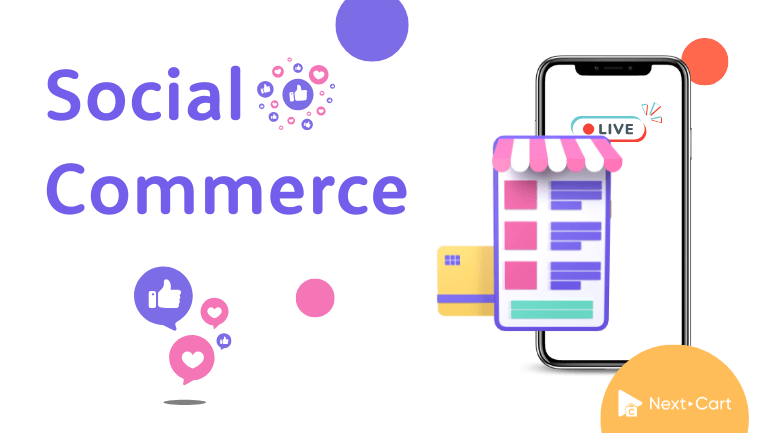
Social media has transformed from a platform for connecting with friends into a dynamic marketplace where brands and consumers interact in real time. Social commerce, the integration of eCommerce directly into social media platforms, is revolutionizing online shopping by making the process seamless and engaging. Platforms like TikTok, Instagram, and Facebook are at the forefront of this evolution, offering in-app shopping, influencer-driven campaigns, and hyper-targeted advertising.
In this article, we will explore what social commerce is, why it is shaping the future of eCommerce, and how brands can leverage it effectively. We’ll also dive into platform-specific social commerce strategies to help businesses maximize their online sales.
- What is Social Commerce?
- Why is Social Commerce Thriving?
- Frictionless Shopping Experience
- Engagement-Driven Shopping
- Influencer & Creator Economy
- Data-Driven Advertising & AI Optimization
- Mobile-First Commerce
- Social Commerce on Leading Platforms
- 1. TikTok Shop – The Viral Shopping Hub
- 2. Instagram Shopping – The Visual Marketplace
- 3. Facebook Shops – The All-in-One Social Storefront
- 4. Pinterest Shopping – The Discovery-Driven Marketplace
- 5. YouTube Shopping – The Video Commerce Giant
- How to Succeed in Social Commerce
- Invest in High-Quality Visual Content
- Leverage Influencer Marketing
- Utilize Data & Analytics
- Engage with Your Audience
- Stay Updated on Platform Changes
- Conclusion
What is Social Commerce?
Social commerce refers to the process of selling products directly through social media platforms, eliminating the need for customers to visit external websites. Unlike traditional eCommerce, where users browse and purchase on dedicated retail websites, social commerce integrates shopping features directly into social networks.
Key features of social commerce include:
- In-App Purchases: Users can discover, browse, and buy products without leaving the social media platform.
- Seamless Checkout Experience: With integrated payment options, social commerce reduces cart abandonment rates.
- User-Generated Content & Reviews: Customers rely on peer reviews, influencer recommendations, and user-generated content to make informed purchasing decisions.
- AI-Powered Personalization: Social platforms leverage AI to curate personalized shopping experiences based on user behavior and preferences.
Why is Social Commerce Thriving?
The rapid growth of social commerce can be attributed to several key trends:
Frictionless Shopping Experience
Consumers today expect convenience. With social commerce, everything from product discovery to checkout happens within the same app, reducing drop-off rates. Features like shoppable posts, one-click checkout, and saved payment methods make transactions quick and easy.
Engagement-Driven Shopping
Social commerce thrives on interactive and engaging experiences. Unlike traditional eCommerce, where static product pages dominate, social commerce introduces:
- Live Shopping Events: Brands and influencers showcase products in real time, allowing customers to ask questions and make instant purchases.
- Augmented Reality (AR) Try-Ons: Platforms like Instagram and Snapchat offer AR-powered filters that allow users to try on makeup, sunglasses, and even clothing before making a purchase.
- Interactive Polls and Q&A Sessions: Engaging customers through interactive content builds brand loyalty and increases conversion rates.
Influencer & Creator Economy
Influencers play a crucial role in social commerce. Their ability to create authentic, engaging content and directly recommend products to their audience makes them invaluable to brands. With affiliate links, brand collaborations, and sponsored posts, influencers are not just content creators but also key sales drivers.
Data-Driven Advertising & AI Optimization
Social platforms use AI-driven algorithms to display the right content to the right audience. Features like personalized product recommendations, automated retargeting ads, and AI chatbots enhance the shopping experience, ensuring high conversion rates.
Mobile-First Commerce
With mobile usage dominating online activities, social commerce is perfectly positioned to capitalize on mobile shopping trends. Consumers spend hours on social media daily, making these platforms ideal for spontaneous and impulse purchases.
Social Commerce on Leading Platforms
From viral TikTok videos to Pinterest mood boards, social commerce is reshaping how we shop. Here’s your playbook for mastering the top platforms—with real-world examples and actionable tips for every feature.
1. TikTok Shop – The Viral Shopping Hub
TikTok isn’t just a place for viral dances—it’s where trends turn into sales. With its fast-paced content and highly engaged audience, TikTok Shop makes impulse buying easier than ever.
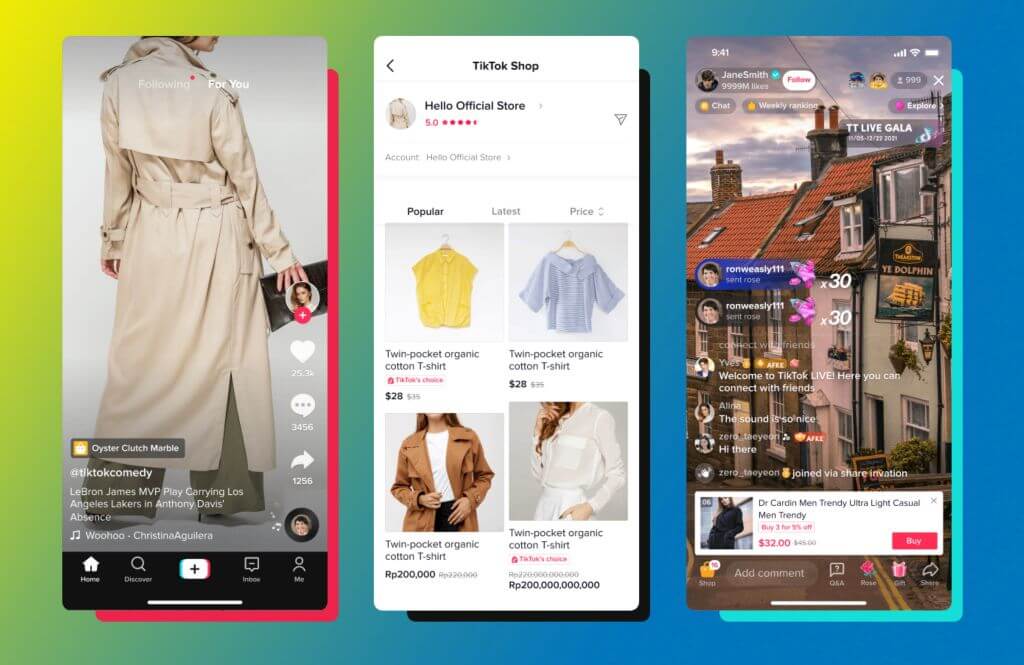
TikTok Shop
Key Features:
- Shoppable Videos & Live Streams: You’re scrolling through TikTok, and a creator is showing off a new lipstick. With a single tap, you can add it to your cart—without ever leaving the app. Live shopping takes this to the next level, where hosts demo products in real time, answer questions, and drop exclusive, time-sensitive discounts. It’s like QVC, but turbocharged for the TikTok generation.
- Affiliate Program for Creators: TikTok influencers aren’t just promoting brands; they’re driving direct sales. A fitness creator might link a protein powder in their video, earning a commission on every sale. This setup lets brands tap into niche communities while influencers get rewarded for their content.
- AI-Powered Product Discovery: Ever feel like TikTok just knows what you want? That’s because the algorithm studies what you watch, like, and share—then surfaces products you’re most likely to buy. A dog owner might see trending pet toys, while a gamer gets recommended the latest RGB keyboard. It’s hyper-personalized shopping at its best.
Best Practices:
- Ride the Trend Wave: TikTok thrives on trends, and brands that jump in early get the most visibility. A skincare brand could hop on the “Get Ready With Me” trend, showcasing a 3-step nighttime routine. The key? Make it feel organic, not like an ad.
- Team Up with Micro-Influencers: Bigger isn’t always better. Creators with 10k–100k followers often have tight-knit, highly engaged audiences. A local coffee shop might collaborate with a foodie influencer for a “morning brew” feature, driving real traffic to their store.
- Go Live with Flash Sales: Live streams are TikTok’s secret sales weapon. Hosting a live shopping event with exclusive promo codes—like “FLASH50” for the first 50 buyers—creates urgency and spikes conversions. It’s fast, interactive, and wildly effective.
2. Instagram Shopping – The Visual Marketplace
Instagram is like a digital shopping mall, where aesthetics meet instant checkout. Whether through stunning posts, engaging Reels, or seamless Stories, it’s the perfect platform for discovery-driven shopping.
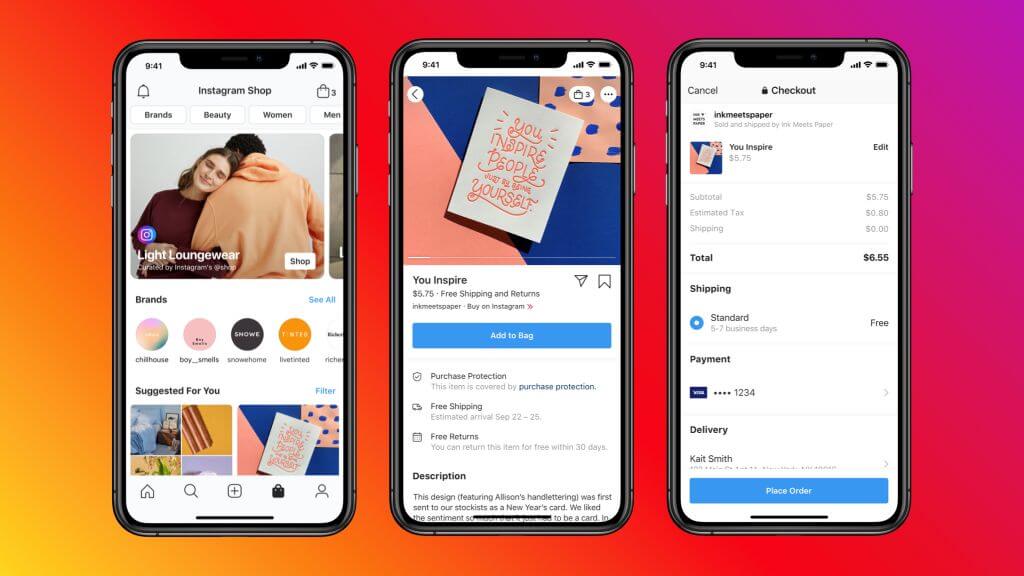
Instagram Shopping
Key Features:
- Shoppable Posts & Stories: That cozy sweater in an influencer’s winter photoshoot? Tap the tag, check the price, and buy it instantly—no need to search elsewhere. Stories take it even further, letting brands add “Swipe Up” links (or “Tap to Shop” stickers) for instant conversions.
- Instagram Checkout: No more redirects or clunky third-party sites. With Instagram Checkout, users save their payment details once and can purchase in just two taps. A jewelry brand using this feature might see conversion rates triple compared to standard links.
- Live Shopping: Imagine a fashion brand hosting a live “Summer Lookbook” event. As models showcase new arrivals, viewers comment, “What sizes are available?” or “How do I style that?”—and they can buy directly from the live stream. It’s shopping, but with real-time engagement.
Best Practices:
- Show Products in Action: A travel brand shouldn’t just post a backpack—it should share a customer’s stunning photo of that backpack at Machu Picchu. User-generated content (UGC) builds trust and inspires purchases.
- Master Reels for Demos: Quick, engaging, and trend-friendly, Reels are perfect for showing off products. A kitchenware brand might create a “5 Ways to Use Our Nonstick Pan” Reel with snappy cuts and upbeat music, keeping viewers hooked till the last second.
- Partner with Nano-Influencers: Influencers with 1k–10k followers might seem small, but their audiences are often hyper-engaged. A sustainable beauty brand could gift products to eco-conscious creators, leading to authentic, high-impact recommendations.
3. Facebook Shops – The All-in-One Social Storefront
Facebook Shops transforms the world’s largest social network into a full-fledged shopping platform. With powerful integrations and broad audience reach, it’s ideal for brands targeting multiple demographics—from Gen Z to Baby Boomers.
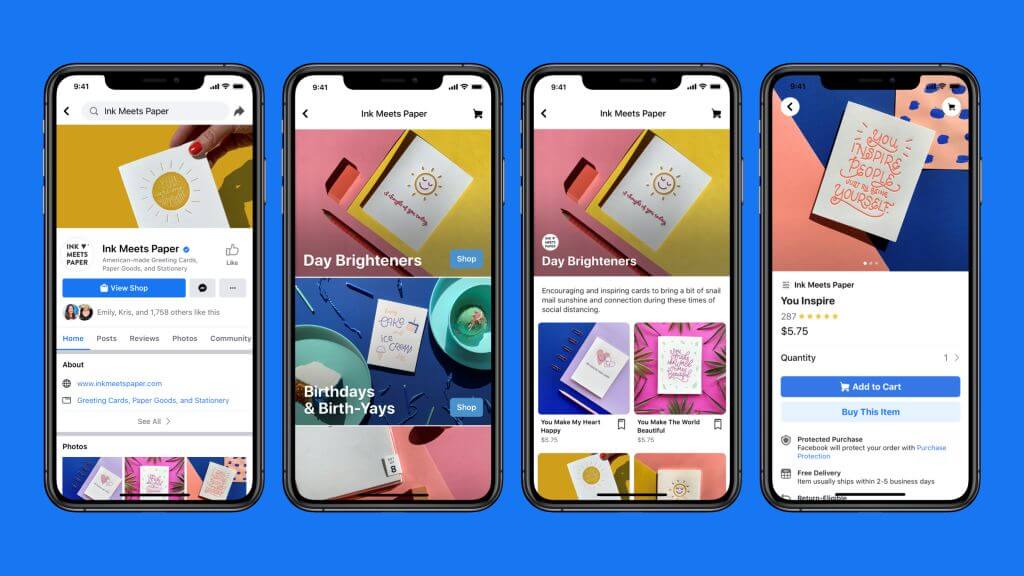
Facebook Shops
Key Features:
- Customizable Shopfronts: Your Facebook Shop isn’t just a product listing—it’s a branded experience. A boutique could design a storefront with soft pastels and elegant fonts, while a tech brand might opt for a sleek, minimalist look. It’s your brand’s identity, fully integrated into Facebook.
- Messenger & WhatsApp Integration: Imagine a customer asks, “Does this dress come in red?” Instead of directing them to a website, your team replies instantly via Messenger or WhatsApp, sends a payment link, and closes the sale—without the customer ever leaving the chat. It’s conversational commerce at its best.
- Cross-Platform Selling: List a product once, and it appears on both Facebook and Instagram. A home decor brand’s new lamp might show up in a Facebook ad and an Instagram Story simultaneously, maximizing visibility and sales potential.
Best Practices:
- Run Targeted Shoppable Ads: Facebook’s ad tools let you retarget users who browsed your website but didn’t buy. A sneaker brand could show carousel ads featuring the exact shoes a visitor checked out, nudging them toward a purchase.
- Build Community with Groups: Creating a “VIP Customer Group” isn’t just about engagement—it’s about fostering brand loyalty. A skincare brand could share exclusive tutorials, offer early access to sales, or even host Q&A sessions with dermatologists.
- Personalize Chat Support: Customers appreciate friendly, human-like interactions. Instead of robotic responses, try: “Hey Sarah! 🌸 Yes, the ‘Sunset Blush’ lipstick is in stock. Want me to set one aside for you?” Small touches like emojis and personalized messages boost engagement and conversions.
4. Pinterest Shopping – The Discovery-Driven Marketplace
Pinterest isn’t just a place for inspiration—it’s where ideas turn into purchases. Whether planning a wedding, redecorating a home, or curating a dream wardrobe, users come ready to shop.
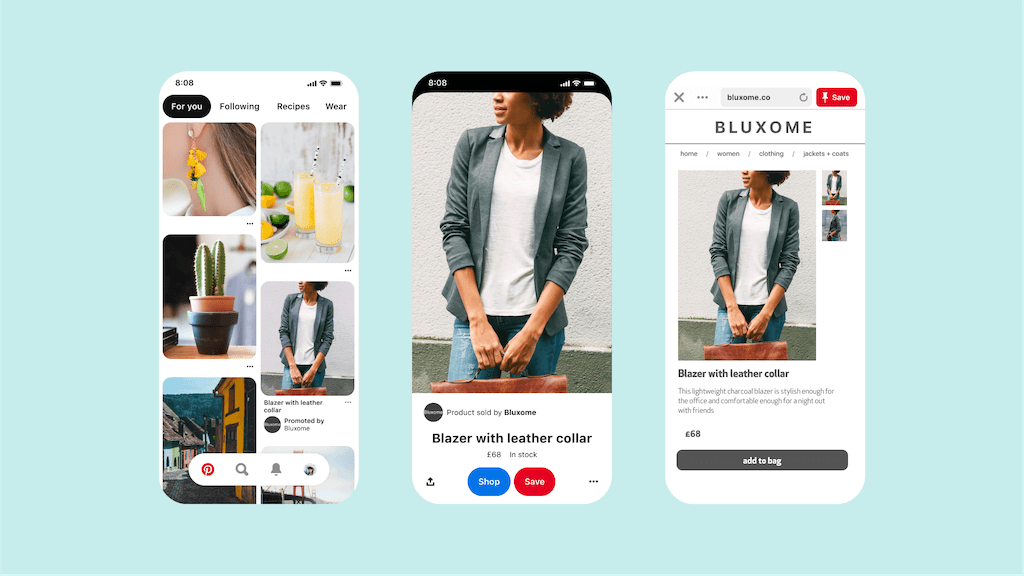
Pinterest Shopping
Key Features:
- Shoppable Pins: A user searching for “Cozy Fall Outfits” spots your pinned sweater—with a price tag and “Buy” button. With just a click, inspiration turns into a sale.
- Product Catalog Integration: Instead of manually pinning every item, brands can sync their entire inventory to Pinterest. A furniture store with 500 products instantly gets 500 shoppable pins, complete with pricing and product details.
- Personalized Shopping Recommendations: Pinterest’s AI doesn’t just show users random products—it curates suggestions based on their pins, boards, and searches. Someone saving “Minimalist Home Decor” ideas will see your brand’s sleek, space-saving furniture right in their feed.
Best Practices:
- Optimize for Search: Think of Pinterest as a visual search engine. Use keyword-rich descriptions like “affordable mid-century desk” or “handmade ceramic mugs” to increase discoverability. The right wording can make or break a sale.
- Use Rich Pins: Standard pins are great, but Rich Pins are better. They display real-time pricing, stock availability, and product info. If a user searches “holiday gift ideas” and sees your pin with a “20% Off Today Only” label, they’re far more likely to click Buy Now.
- Create Mood Boards: Instead of pinning products randomly, organize them into themed collections. A camping gear brand could have boards like “Weekend Warrior Essentials” or “Glamping Must-Haves.” This helps customers visualize how products fit into their lifestyle—and makes purchasing decisions easier.
5. YouTube Shopping – The Video Commerce Giant
YouTube isn’t just for cat videos anymore—it’s a shopping powerhouse. With its massive audience and engaging video content, YouTube Shopping lets brands and creators turn views into sales.
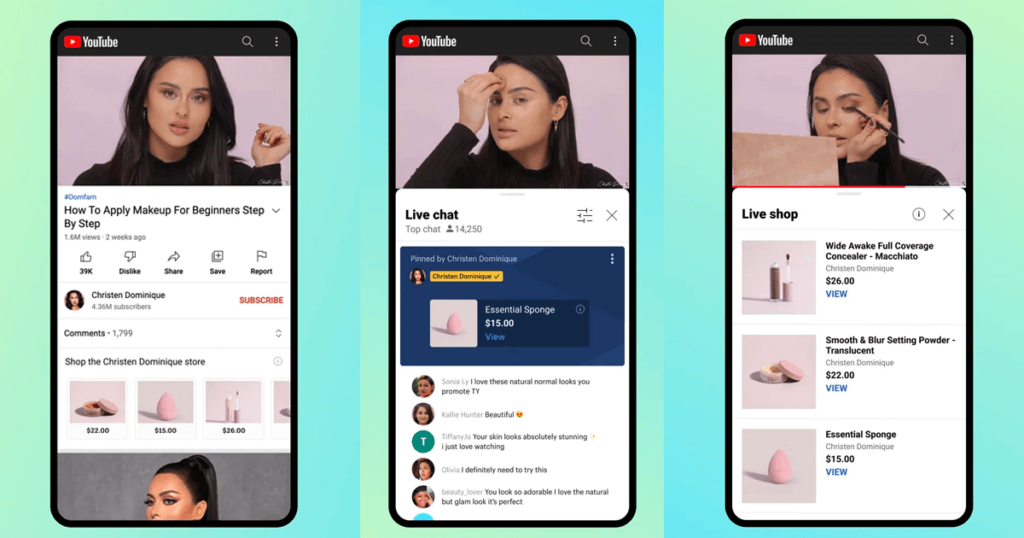
YouTube Shopping
Key Features:
- Shoppable Videos & Live Streams: Picture this—you’re watching a beauty tutorial, and right below the video, there’s a link to buy the exact foundation the creator is using. No need to search or leave the platform. Live shopping events take things further, with hosts demonstrating products in real time, answering viewer questions, and dropping exclusive deals. Think of it as a modern-day home shopping network, but way more interactive.
- Product Tagging in Videos & Shorts: YouTube makes shopping seamless by letting creators tag products directly in their content. Imagine a fitness influencer sharing their “10-Minute Home Workout” routine and tagging the exact dumbbells and resistance bands they’re using. Viewers can tap the tags, check out the products, and keep watching—no interruptions, just effortless shopping.
- Integration with Shopify & Merch Shelf: Brands can connect their Shopify stores directly to YouTube, turning their videos into shoppable experiences. A fashion brand showcasing a “Fall Lookbook” can have every featured outfit listed right below the video. Even individual creators can showcase their own merch with the built-in Merch Shelf, making it easier than ever for fans to support their favorite channels.
Best Practices:
- Create Honest Product Reviews: People turn to YouTube for in-depth, unbiased reviews before making a purchase. If a tech brand launches a new wireless earbud, they should collaborate with a creator who can test its sound quality, battery life, and comfort—and share both pros and cons. Authenticity builds trust, and trust converts viewers into buyers.
- Leverage YouTube Shorts: Shorts are YouTube’s answer to TikTok—fast, engaging, and perfect for product teasers. A skincare brand could create a 15-second Short titled “3 Ways to Use Our Hydrating Serum,” showing quick demos with a call-to-action link. These bite-sized videos keep viewers engaged while driving instant clicks.
- Host Live Shopping Events: Going live on YouTube isn’t just about engagement—it’s a sales powerhouse. Brands can demo products, answer live questions, and drop exclusive promo codes like “LIVE20” for limited-time deals. Tease the event with Shorts and community posts to build anticipation, then drive conversions with interactive, real-time shopping.
How to Succeed in Social Commerce
To build a thriving social commerce strategy, brands need to go beyond just listing products on social platforms. Success requires a mix of engaging content, smart marketing, and data-driven decisions. Here’s how you can stand out:
Invest in High-Quality Visual Content
Success in social commerce begins with an unwavering commitment to quality, starting with high-quality visual content. In today’s visually driven digital landscape, brands must ensure that every image and video speaks to their aesthetic and quality. Investing in professional photography, engaging video content, and even immersive AR experiences can transform a simple product showcase into a compelling narrative that captures the essence of the brand. When products are presented beautifully, customers are naturally drawn to explore and eventually make a purchase, creating a seamless bridge between visual appeal and online sales.
Leverage Influencer Marketing
Equally important is the strategic use of influencer marketing. In the social media sphere, influencers hold a unique position as trusted voices among their followers. By partnering with content creators whose values align with your brand, you can tap into their established audiences, fostering authentic relationships that drive engagement and conversions. Influencers do more than just promote products; they tell stories that resonate with potential buyers, effectively transforming traditional advertising into a genuine conversation about the brand’s offerings.
Utilize Data & Analytics
Data and analytics play a critical role in refining your social commerce strategy. With every post, video, or campaign, platforms generate valuable data that can reveal consumer behaviors and preferences. By closely monitoring engagement rates, conversion metrics, and customer demographics, brands can fine-tune their content and marketing strategies to better meet the needs of their audience. This data-driven approach ensures that every decision is informed by real insights, allowing brands to continuously optimize their efforts for maximum impact.
Engage with Your Audience
Engaging with your audience is the heartbeat of social commerce. Building a strong community around your brand involves more than simply broadcasting a message; it requires two-way communication. When brands actively respond to comments, initiate Q&A sessions, and create interactive content, they build trust and foster loyalty among their customers. This personal touch not only humanizes the brand but also encourages users to become active participants in the brand’s journey, turning casual shoppers into lifelong advocates.
Stay Updated on Platform Changes
Finally, staying updated on platform changes is essential in an ever-evolving digital landscape. Social media platforms are in a constant state of flux, regularly introducing new features and refining algorithms to enhance user experience. For brands, this means continuously monitoring industry news, testing emerging tools, and adapting to new trends. Whether it’s the latest update on TikTok Shop or new features in Instagram Shopping, being an early adopter of innovative solutions can provide a competitive edge and ensure that your social commerce strategy remains both current and effective.
By weaving together high-quality visuals, authentic influencer collaborations, data-driven insights, genuine audience engagement, and a proactive approach to platform changes, brands can create a dynamic and effective social commerce strategy. This holistic approach not only drives immediate sales but also builds a lasting connection with customers, ensuring long-term success in the rapidly evolving world of social commerce.
Conclusion
Social commerce is not just a trend—it’s the future of online shopping. With platforms like TikTok, Instagram, Facebook, and Pinterest leading the way, brands must embrace this shift to stay competitive. By focusing on seamless shopping experiences, influencer collaborations, and AI-driven personalization, businesses can unlock the full potential of social commerce.
Are you ready to take advantage of this new eCommerce frontier? Start leveraging social commerce today to drive sales, build brand awareness, and connect with customers in meaningful ways.